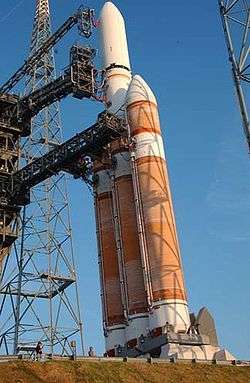Modular rocket

A modular rocket is a type of multistage rocket which features components that can be interchanged for specific mission requirements. Several such rockets use similar concepts such as unified modules to minimize expenses on manufacturing, transportation and for optimization of support infrastructure for flight preparations.
The National Launch System study (1991-1992) looked at future launchers in a modular (cluster) fashion. This concept has existed since the creation of NASA.
Examples
Saturn C-x
A government commission, the "Saturn Vehicle Evaluation Committee" (better known as the Silverstein Committee), assembled in 1959 to recommend specific directions that NASA could take with the existing Army rocket program (Jupiter, Redstone, Sergeant). NASA's Space Exploration Program Council (1959-1963) was tasked with developing the launch architecture for the new Saturn rocket series. The Saturn C-x architecture consisted of five different stages (S-I, S-II, S-III, S-IV, and S-V/Centaur) that could be stacked vertically for specific rockets to meet various NASA payload and mission requirements.
This work led to development of the Saturn I, Saturn IB, and Saturn V rockets.
Atlas V
The Atlas V expendable launch system uses the liquid fueled Common Core Booster as its first stage. In most configurations a single CCB is used with strap-on solid rocket boosters. A proposed configuration for heavier loads strapped together three CCBs for the first stage. The Common Core Booster utilizes the Russian made RD-180 burning RP-1 fuel with liquid oxygen producing a thrust of 3.8 MN. The liquid propellant tanks use an isogrid design for strength, replacing previous Atlas tank designs which were pressure stabilized.[1]
The length of the common core booster is 89 feet (27 m), and has a diameter of 12.5 feet (3.8 m).[2]
Delta IV
The Delta IV launcher family uses the liquid fuel Common Booster Core as the first stage of the various rocket configurations. One or three modules can be used as the first stage. In most configurations a single CBC is used with or without strap-on SRBs. Three CBCs together form the first stage of the Heavy configuration. The CBC uses the Rocketdyne RS-68 engine and burns liquid hydrogen with liquid oxygen producing a thrust of 2.9 meganewtons (650,000 lbf).
Angara
The Universal Rocket Module (URM) is the modular liquid fueled first stage of the Angara expendable launch system. Depending on the configuration, the first stage can consist of 1, 3, 5 or 7 URMs. Each URM uses a Russian-made RD-191 engine burning RP-1 fuel with liquid oxygen producing a thrust of 1.92 MN.[3]
Falcon Heavy
The Falcon Heavy launch vehicle consists of a strengthened Falcon 9 Full Thrust center core with two regular Falcon 9 Full Thrust core stages acting as liquid strap-on boosters. Each core is powered by nine Merlin 1D engines burning rocket-grade kerosene fuel with liquid oxygen producing almost 7.7 meganewtons (1,700,000 lbf) of thrust, and all three cores together producing over 22MN of thrust. A first design of the Falcon Heavy included a unique propellant crossfeed capability, where fuel and oxidizer to power most of the engines on the center core would be fed from the two side cores, up until the side cores would be near empty and ready for the first separation event.[4] However, due to its extreme complexity this feature was cancelled in 2015 leaving each of the three cores to burn their own fuel.
Like the single stick Falcon 9, each Falcon Heavy booster core is reusable.[5] After the side cores are released, the center engine in each side core will continue to burn for a few seconds in order to control the trajectory of the side boosters.[6] The Falcon Heavy Test Flight thus demonstrated the two side boosters landing simultaneously near their launch site, while the central booster attempted a landing on SpaceX's Autonomous spaceport drone ship, which resulted in a hard landing near the ship.
A Falcon Heavy launch that succeeds in recovering all three core boosters has the same material expenditure as the Falcon 9, i.e. the upper stage. As such, the difference in cost between a Falcon 9 and a Falcon Heavy launch is limited, mainly to the extra fuel and refurbishing three as opposed to one booster core.
See also
External links
References
- ↑ Launch Vehicles Archived 2011-11-11 at the Wayback Machine., Lockheed Martin
- ↑ Lockheed Martin Names New Rocket Atlas V Archived 2010-02-23 at the Wayback Machine., Lockheed Martin
- ↑ Rocket family «Angara», Khrunichev State Research and Production Space Center
- ↑ Strickland, John K., Jr. (September 2011). "The SpaceX Falcon Heavy Booster". National Space Society. Retrieved 2012-11-24.
- ↑ Simberg, Rand (2012-02-08). "Elon Musk on SpaceX's Reusable Rocket Plans". Popular Mechanics. Retrieved 2012-02-07.
- ↑ Nield, George C. (April 2014). Draft Environmental Impact Statement: SpaceX Texas Launch Site (PDF) (Report). 1. Federal Aviation Administration, Office of Commercial Space Transportation. p. 2-3. Archived from the original on 2013-12-07.
The center core engines are throttled down after liftoff and up to two engines may be shut down as the vehicle approaches maximum acceleration. After the side boosters drop off, the center core engines throttle back up to full thrust. The center engine in each side core continues to burn for a few seconds after separation to control the trajectory of the booster.
- ↑ Universal Rocket series was a Soviet project of unified rocket systems (military and civilian); UR-700 project was supposed to use liquid fuel boosters with similar design to its first stage.